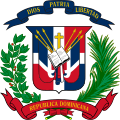Portal:Dominican Republic
Introduction
The Dominican Republic is a North American country located on the island of Hispaniola in the Greater Antilles of the Caribbean Sea in the North Atlantic Ocean. It shares a maritime border with Puerto Rico to the east and a land border with Haiti to the west, occupying the eastern five-eighths of Hispaniola which, along with Saint Martin, is one of only two islands in the Caribbean shared by two sovereign states. In the Antilles, the country is the second-largest nation by area after Cuba at 48,671 square kilometers (18,792 sq mi) and second-largest by population after Haiti with approximately 11.4 million people in 2024, of whom 3.6 million reside in the metropolitan area of Santo Domingo, the capital city. The Dominican Republic has the largest economy in the Caribbean and the seventh-largest in Latin America. Over the last 25 years, the Dominican Republic has had the fastest-growing economy in the Western Hemisphere – with an average real GDP growth rate of 5.3% between 1992 and 2018. GDP growth in 2014 and 2015 reached 7.3 and 7.0%, respectively, the highest in the Western Hemisphere. Recent growth has been driven by construction, manufacturing, tourism, and mining. The country is the site of the third largest (in terms of production) gold mine in the world, the Pueblo Viejo mine. The gold production of the country is 31 metric tonnes in 2015. The Dominican Republic is the most visited destination in the Caribbean. A geographically diverse nation, the Dominican Republic is home to both the Caribbean's tallest mountain peak, Pico Duarte, and the Caribbean's largest lake and lowest point, Lake Enriquillo. The island has an average temperature of 26 °C (78.8 °F) and great climatic and biological diversity. The country is also the site of the first cathedral, palace, monastery, and fortress built in the Americas, located in Santo Domingo's Colonial Zone, a World Heritage Site. (Full article...) Selected article -The Dominican Restoration War or the Dominican War of Restoration (Spanish: Guerra de la Restauración, Guerra de Santo Domingo) was a guerrilla war between 1863 and 1865 in the Dominican Republic between nationalists and Spain, the latter of which had recolonized the country 17 years after its independence. The war resulted in the restoration of Dominican sovereignty, the withdrawal of Spanish forces, the separation of the Captaincy General of Santo Domingo from Spain, and the establishment of a second republic in the Dominican Republic. During the period of the First Dominican Republic, the nation endured repeated attacks from Haiti, and annexation attempts from France, Spain, Great Britain, and the United States, all of which threatened national sovereignty. Also posing a threat to the nation was the dictatorial ways of the presidents who during those years alternated in power. Pedro Santana and Buenaventura Báez were the two prolific politicians competing during this time. At the end of his last term, Pedro Santana decided to annex the country to Spain; His idea was to end the permanent threats from Haiti, but also to remain in power, since in exchange he accepted the position of captain general of the new Spanish province of Santo Domingo. Such a decision would unleash the Dominican Republic's second war of independence. Elements of a civil war also takes place, as this conflict pits the supporters of annexation to Spain against the independentistas or restorers (since their objective was to restore the First Republic). (Full article...) General images -The following are images from various Dominican Republic-related articles on Wikipedia.
Selected picture -The National Palace is a building in Santo Domingo, that houses the offices of the Executive Branch (Presidency and Vice Presidency) of the Dominican Republic.
Selected biography -Bethania de la Cruz de Peña (born May 13, 1987) is a volleyball player from the Dominican Republic, currently playing for the Omaha Supernovas of the Pro Volleyball Federation. She is best known for winning the gold medal with the Dominican women's national team at the 2009 NORCECA Championship and the 2010 Pan-American Cup. (Full article...) Related portalsWikiProjects
Things to do
Associated WikimediaThe following Wikimedia Foundation sister projects provide more on this subject:
SourcesDiscover Wikipedia using portals | |||||||||||||||||||||||||



















































































